 David Honig is a graduate student in marine science at Duke University in the lab of Dr. Cindy Van Dover. He is participating in LARISSA, a 2 month multinational expedition to study the causes and consequences of the ice shelf collapse. He will be posting regular updates on the expedition exclusively for Deep Sea News readers!
David Honig is a graduate student in marine science at Duke University in the lab of Dr. Cindy Van Dover. He is participating in LARISSA, a 2 month multinational expedition to study the causes and consequences of the ice shelf collapse. He will be posting regular updates on the expedition exclusively for Deep Sea News readers!
——————————
6 February 2010
Sampling the Inverted Benthos
The Palmer has spent the last four days south of James Ross Island waiting for clear skies in order to access geological sampling sites on the Peninsula via helicopter. Heavy snowfall has smoothed the pack ice into a featureless white sheet that extends south to the horizon. Indications that we are at sea—rocking of the ship, waves crashing against the hull, birds wheeling overhead—are absent. It is tempting to draw analogies between our present station and one of the vast, white deserts in the Antarctic interior.
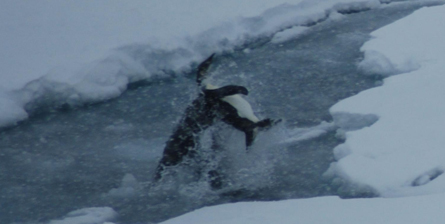
Tempting, that is, until a leopard seal exploded out of the water with an emperor penguin struggling in its jaws. Leopard seals are top predators and require waters productive enough to sustain stocks of their preferred prey, penguins and other seals. So despite its blank surface, the ocean here must be very much alive.
Curiously, the CTD fluorometer reports only trace levels of chlorophyll in the water column. If there is effectively no phytoplankton, then what primary producers support this ecosystem? What lives here that can build biomass from inorganic molecules? The answer becomes apparent when the ship moves, leaving behind a wake of cracked and overturned ice streaked with olive green. We scooped chunks of this dirty-looking ice onboard yesterday for a closer look. The streaks consisted of either densely packed, millimeter-wide vertical channels inside the ice or slime at the ice-water interface. Melting the ice in buckets precipitated bright green, mucous-covered strings and brownish fluff. Inspection under the microscope revealed these fractions to be microalgae and diatoms, respectively, interspersed with the occasional photosynthetic dinoflagellate (a type of protist). Collectively, this community of primary producers is called “sea-ice algae” and it contributes to the base of the food web ultimately supporting our leopard seal and its penguin prey.
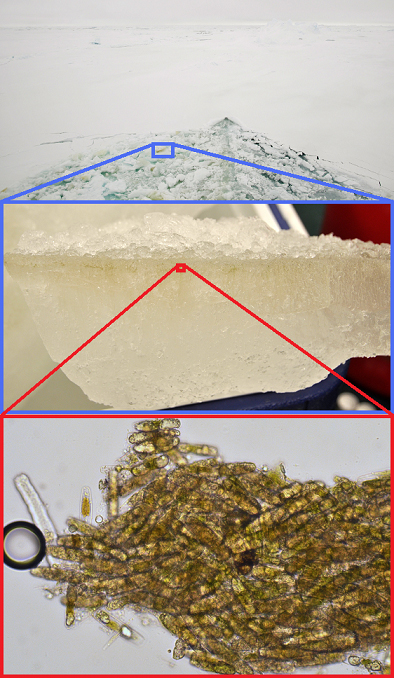
Sea ice forms an ocean roof that in many ways mirrors the ocean floor. Like seafloor sediments, sea-ice communities are species-rich. With a taxonomic key in hand, we might have identified tens of species of microalgae and perhaps 100 species of diatoms, although succession often leads to just a few species dominating. Just as sediment hosts infauna, sea ice hosts microscopic herds of herbivores. Crustaceans called copepods and amoeboid protists called foraminifers inhabit brine channels inside the ice where the temperature stays below 0 °C and salt concentrations approach Utah’s Great Salt Lake. Foraminifers are transient visitors that can also be found suspended in the water column. At least two species of copepods, on the other hand, pass their entire lives grazing within the ice. And just as invertebrate deposit feeders graze along the surface of the seafloor, larger zooplankton such as krill swim upside-down beneath the ice to graze on microalgae and diatoms. For these reasons, sea-ice is often called the “inverted benthos.”
The scant few grams dry weight of microalgae and diatoms thawed from our cubic foot of inverted benthos may not look like much, but on a regional scale the ice is staggeringly productive. The halo of sea ice surrounding Antarctic swells from 4 to 20 million square kilometers in extent every austral winter, or roughly one-half to twice the land area of the United States. Primary producers associated with Antarctic sea ice produce about 35.7 Teragrams of organic carbon per year. If the average human weighs 75 kg, is 70% water, 20% bone, and 10% carbon, then Antarctic sea-ice algae annually produces enough carbon to make 5 billion people! The ice-shrouded Weddell Sea (recall our trouble reaching the Larsen B embayment) alone accounts an annual harvest of 2.5 billion human-carbon equivalents.
Primary production estimates such as these derive from satellite images of sea-ice chlorophyll content. Tracking the ecological fate of organic matter produced in sea ice, however, requires fieldwork. We will occasionally sample sea-ice algae during the next month to quantify the extent consumers in the benthos rely on primary producers in the overlying inverted benthos. To do this, we will measure the chemical composition sea-ice algae as well as kelp, phytoplankton, chemoautotrophic bacteria, and (ideally) all other primary producers present in the ecosystem. These measurements will form a library of chemical tracers we can then use to investigate diets of individual consumers.
One tracer we will include in our library is the ratio of the rare 13C stable isotope of carbon to the more common 12C stable isotope. This tracer distinguishes between phytoplankton and sea-ice algae because enzymes that fix atmospheric CO2 into organic compounds preferentially react with CO2 molecules containing 12C. Phytoplankton is immersed in a steady supply of 12CO2 and manufactures molecules that contain mostly 12C. Primary producers locked in ice, on the other hand, quickly deplete the lighter isotope and are forced to incorporate kinetically unfavorable 13CO2, resulting in the production of biomass that is distinctly enriched in 13C. Since carbon stable isotope compositions of organic matter change little with each trophic step, benthic consumers enriched in 13C can be inferred to rely substantially on organic matter derived from sea-ice algae if no other 13C-enriched primary producers are present in the ecosystem. Furthermore, if we are confident that we have measured the carbon stable isotope composition of the each potential primary producer in the ecosystem, we can use a mixing model to calculate the proportional contribution of each primary producer to a given consumer’s diet.
What is the carbon stable isotope composition of the red smear left behind by the leopard seal? Perhaps organic carbon entering the marine food web as green streaks of ice algae may eventually color the snow as penguin blood.

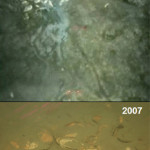

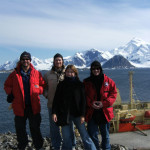

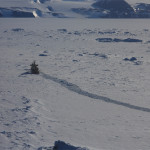
I like the human carbon equivilant numbers. It makes it a lot more reasonable that the Antarctic waters should support the world’s largest animals.
Is the Arctic similarly productive? I guess it must do OK, given the amount of life in Arctic waters but I wonder which is richest, north or south?